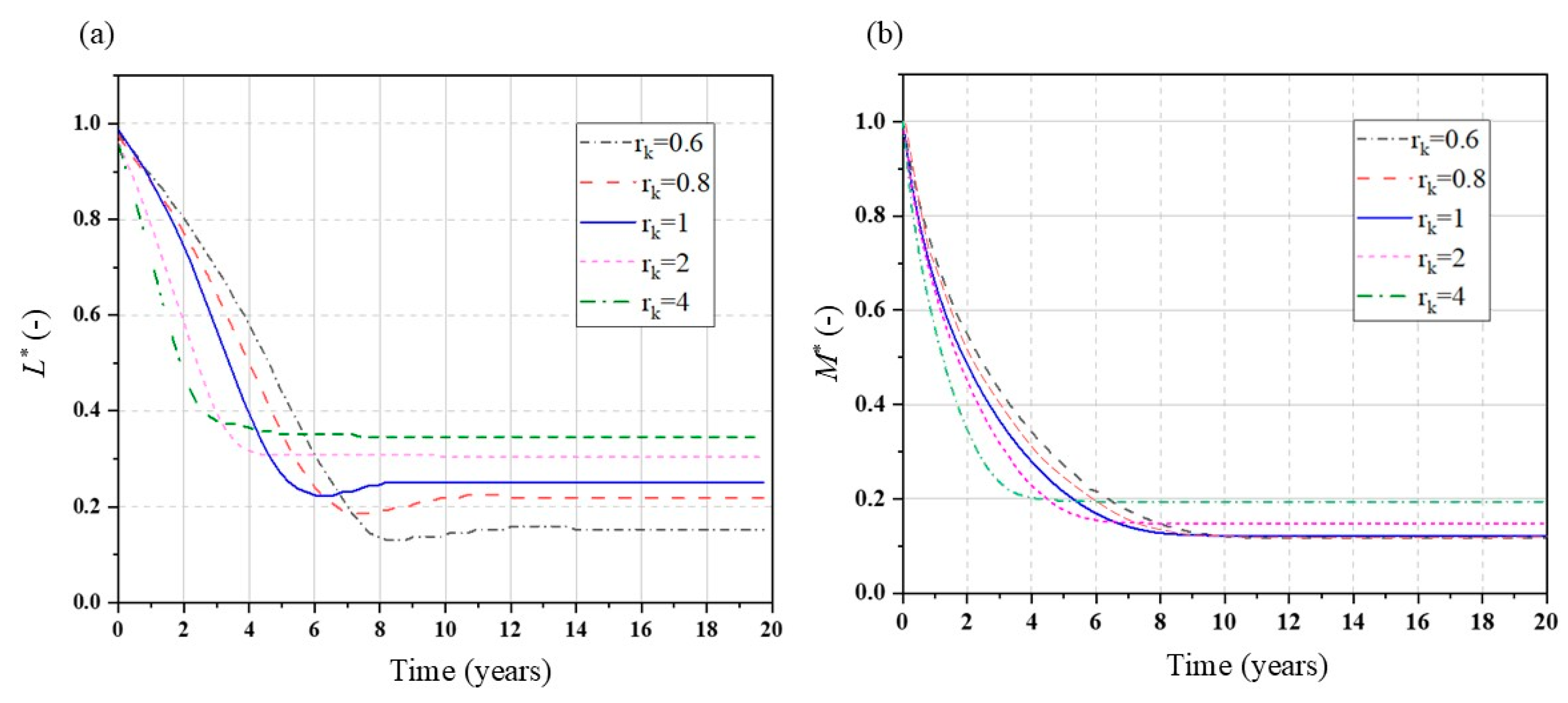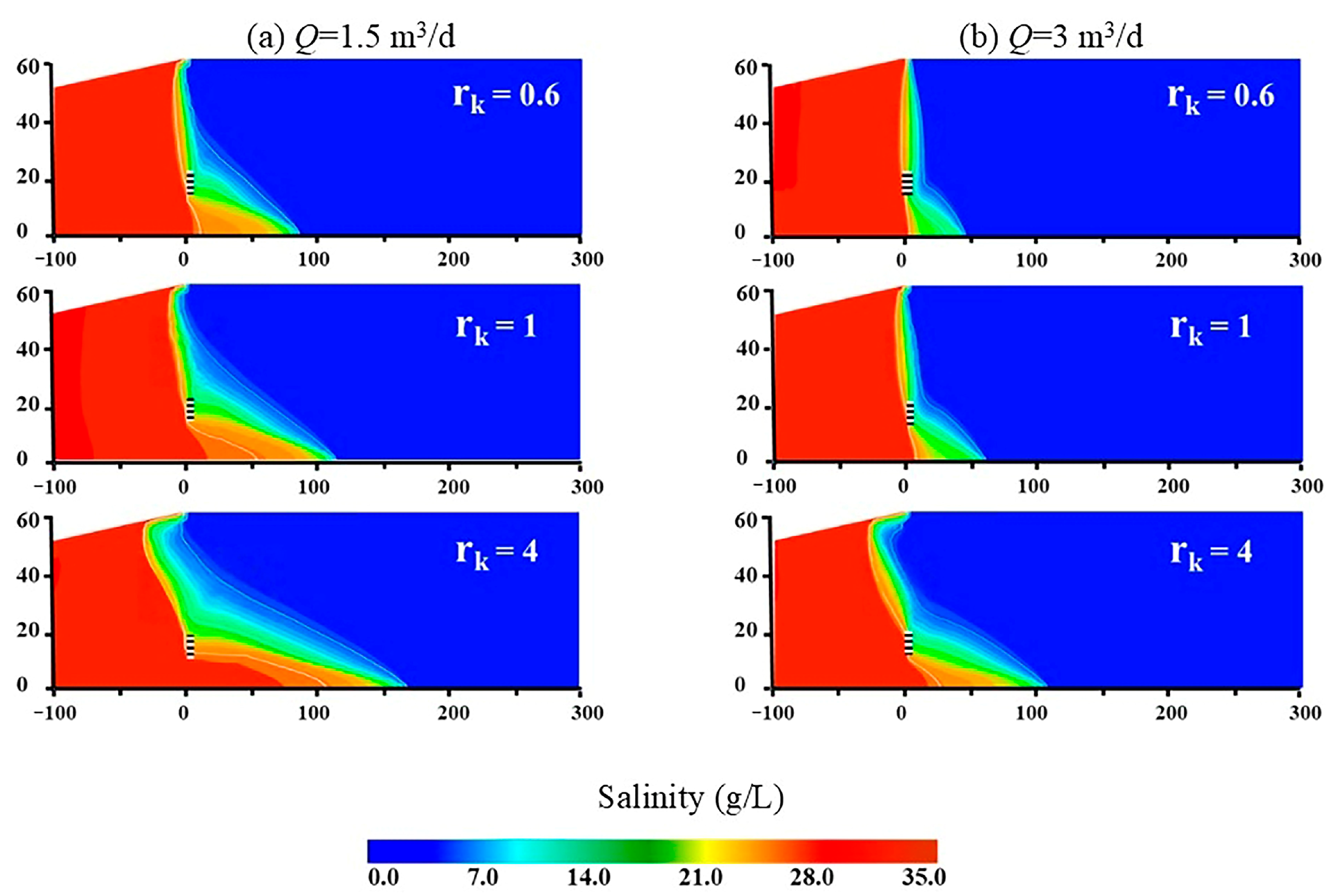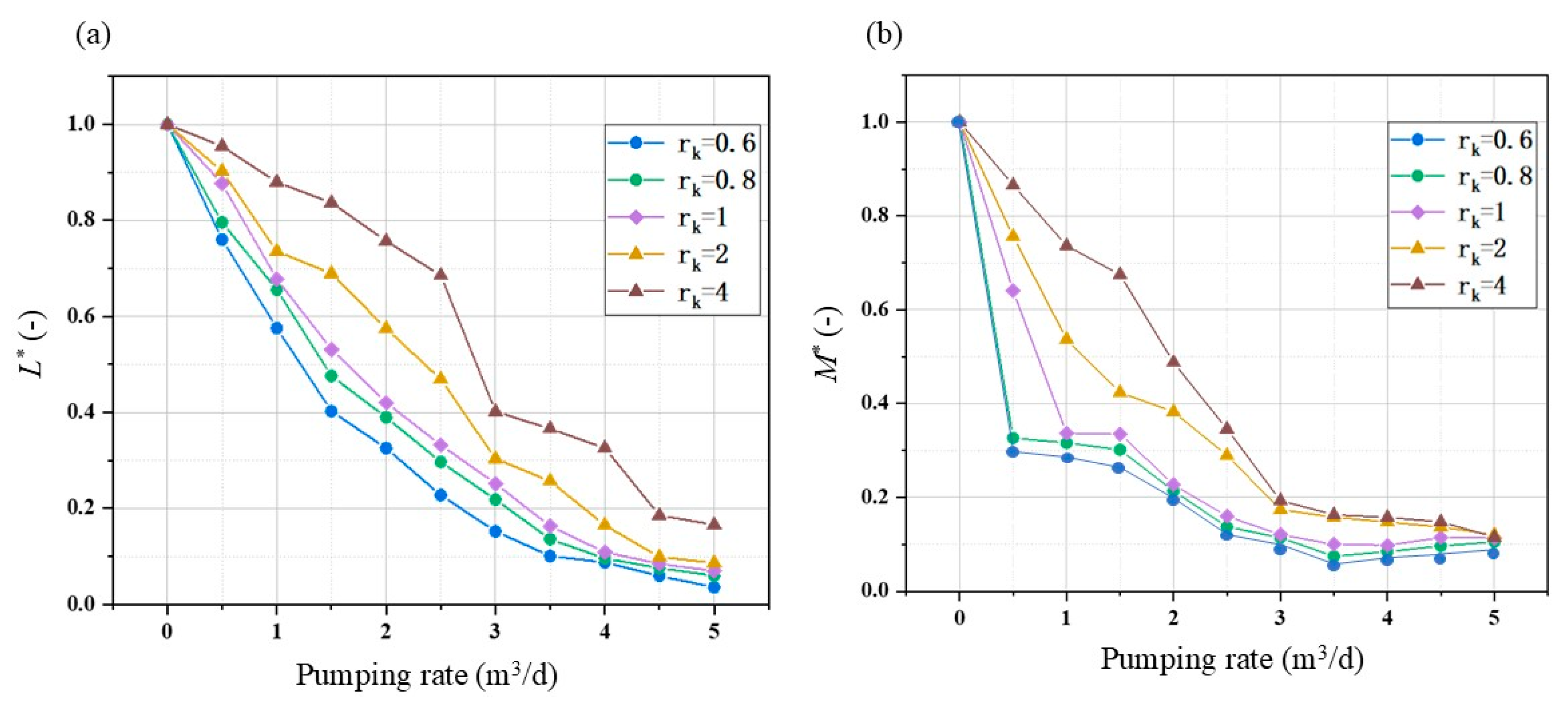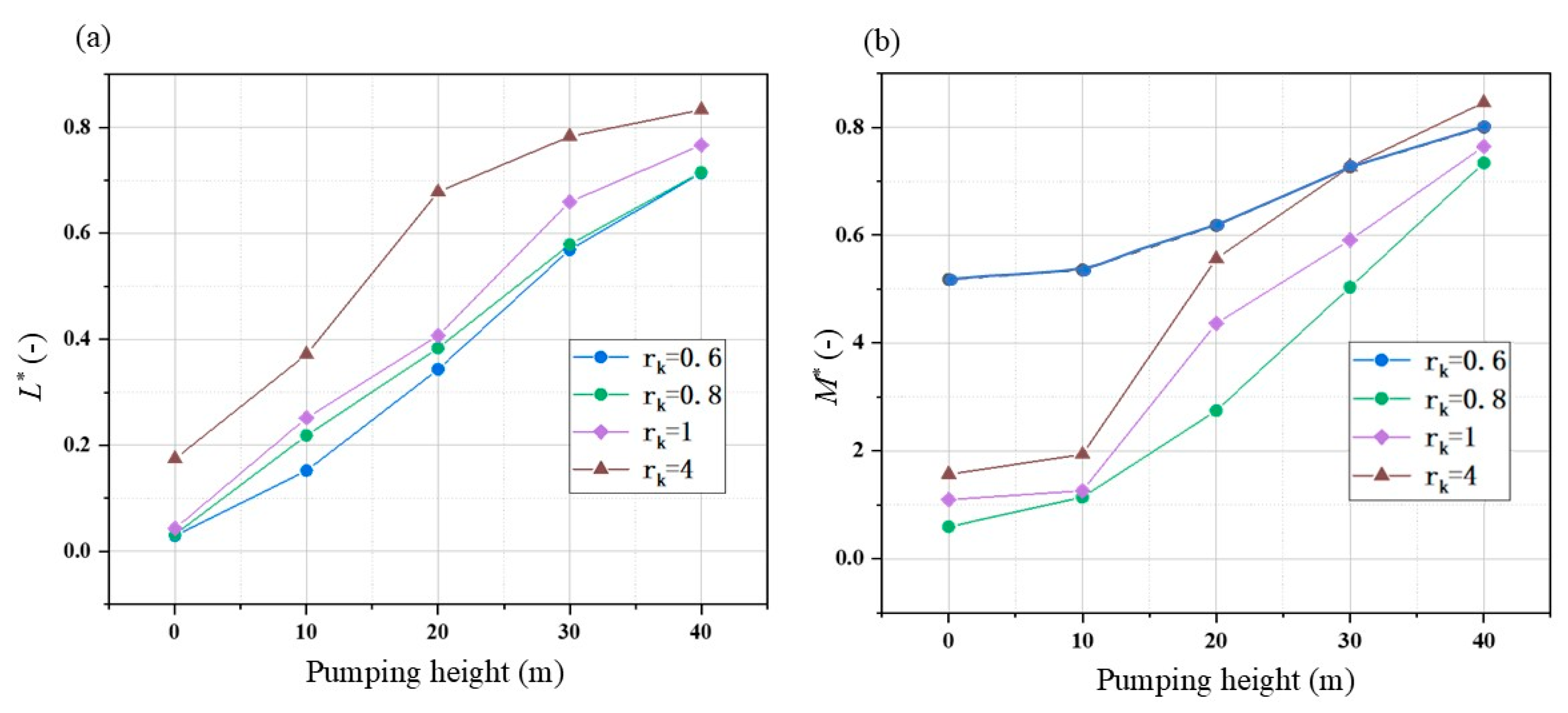Effect of Anisotropy on Saline Groundwater Pumping Efficiency for Seawater Intrusion Control
Abstract
1. Introduction
2. Methods
2.1. Conceptual Model
2.2. Numerical Simulation and Implementation
2.3. Data Analysis
2.3.1. Quantitative Metrics
2.3.2. Temporal and Spatial Evolution Analysis
2.3.3. Sensitivity Analysis of Critical Parameters
3. Results and Discussion
3.1. Influence of Anisotropy on Flow and Salinity Distribution
3.2. Effects of Pumping Rate on Anisotropy-Barrier Interactions
3.3. Sensitivities of Pumping Height to Anisotropy–Barrier Interactions
4. Conclusions
- (1)
- Anisotropy dictates salt removal pathways. Low-anisotropy-ratio conditions enhance horizontal flow dominance, but suppress vertical mixing, promoting residual salt retention through constrained solute exchange. High anisotropy accelerates vertical convection, enabling rapid initial wedge retreat, yet simultaneously destabilizes interfacial hydrodynamics, triggering secondary flows that drive inland saltwater reinvasion.
- (2)
- Pumping parameters modulate anisotropy–barrier synergy. Elevated pumping rates homogenize system responses by overwhelming hydraulic conductivity contrasts, while well depth governs process dominance: deeper installations activate density-driven convection that masks anisotropy effects, whereas shallower positions leverage horizontal hydraulic conductivity to optimize freshwater capture.
- (3)
- Engineering optimization requires objective-specific designs. Minimizing residual wedge geometry favors balanced anisotropy with deeper well screens to harness convective scavenging. Maximizing total salt removal necessitates low anisotropy ratios with moderate pumping to enhance lateral displacement. Aggressive pumping clears mobile salts, but fails to purge deep brine reservoirs, incurring disproportionate energy penalties.
- (4)
- Anisotropy-imposed transport thresholds preclude universal optimization. Interfacial stability requires moderate anisotropy, whereas salt mobilization demands extreme hydraulic conductivity ratios, making simultaneous minimization of L* and M* unachievable.
Supplementary Materials
Author Contributions
Funding
Data Availability Statement
Conflicts of Interest
References
- Barragán, J.M.; De Andrés, M. Analysis and trends of the world’s coastal cities and agglomerations. Ocean Coast. Manag. 2015, 114, 11–20. [Google Scholar] [CrossRef]
- Perumal, M.; Sekar, S.; Carvalho, P.C. Global investigations of seawater intrusion (SWI) in coastal groundwaters in the last two decades (2000–2020): A bibliometric analysis. Sustainability 2024, 16, 1266. [Google Scholar] [CrossRef]
- Yu, P.; Liu, H.; Wang, Z.; Fu, J.; Zhang, H.; Wang, J.; Yang, Q. Development of Urban Underground Space in Coastal Cities in China: A Review. Deep Undergr. Sci. Eng. 2023, 2, 148–172. [Google Scholar] [CrossRef]
- Watson, T.A.; Werner, A.D.; Simmons, C.T. Transience of seawater intrusion in response to sea level rise. Water Resour. Res. 2010, 46, W12533. [Google Scholar] [CrossRef]
- Cao, T.; Han, D.; Song, X. Past, present, and future of global seawater intrusion research: A bibliometric analysis. J. Hydrol. 2021, 603, 126844. [Google Scholar] [CrossRef]
- Silverman, J.; Strauch-Gozali, S.; Asfur, M. The Influence of fresh submarine groundwater discharge on seawater acidification along the northern Mediterranean coast of Israel. J. Geophys. Res. Ocean. 2024, 129, e2024JC021010. [Google Scholar] [CrossRef]
- Panthi, J.; Pradhanang, S.M.; Nolte, A.; Boving, T.B. Saltwater intrusion into coastal aquifers in the contiguous United States—A systematic review of investigation approaches and monitoring networks. Sci. Total Environ. 2022, 836, 155641. [Google Scholar] [CrossRef]
- Jeen, S.W.; Kang, J.; Jung, H.; Lee, J. Review of seawater intrusion in western coastal regions of South Korea. Water 2021, 13, 761. [Google Scholar] [CrossRef]
- Zhang, Z.; Yi, L. Research methods for seawater intrusion in China and recommendations for novel radium-radon technologies. Mar. Environ. Res. 2024, 198, 106530. [Google Scholar] [CrossRef] [PubMed]
- Stein, S.; Shalev, E.; Sivan, O.; Yechieli, Y. Challenges and approaches for management of seawater intrusion in coastal aquifers. Hydrogeol. J. 2023, 31, 19–22. [Google Scholar] [CrossRef]
- Abd-Elaty, I.; Ramadan, E.M.; Elbagory, I.A.; Nosair, A.M.; Kuriqi, A.; Garrote, L.; Ahmed, A.A. Optimizing Irrigation Systems for Water Efficiency and Groundwater Sustainability in the Coastal Nile Delta. Agric. Water Manag. 2024, 304, 109064. [Google Scholar] [CrossRef]
- Cantelon, J.A.; Guimond, J.A.; Robinson, C.E.; Michael, H.A.; Kurylyk, B.L. Vertical saltwater intrusion in coastal aquifers driven by episodic flooding: A review. Water Resour. Res. 2022, 58, e2022WR032614. [Google Scholar] [CrossRef]
- Zhan, L.; Xin, P.; Chen, J. Subsurface salinity distribution and evolution in low-permeability coastal areas after land reclamation: Field investigation. J. Hydrol. 2022, 612, 128250. [Google Scholar] [CrossRef]
- Gao, S.; Zheng, T.; Zheng, X.; Walther, M. Influence of layered heterogeneity on nitrate enrichment induced by cut-off walls in coastal aquifers. J. Hydrol. 2022, 609, 127722. [Google Scholar] [CrossRef]
- Luyun Jr, R.; Momii, K.; Nakagawa, K. Effects of recharge wells and flow barriers on seawater intrusion. Groundwater 2011, 49, 239–249. [Google Scholar] [CrossRef]
- Gao, S.; Zheng, T.; Wang, X.; Zheng, X.; Qin, C.; Liang, X.; Lu, C. Submarine groundwater discharge and its components in response to negative hydraulic barriers. J. Hydrol. 2024, 631, 130744. [Google Scholar] [CrossRef]
- Gao, S.; Zheng, T.; Luo, J.; Zheng, X.; Fang, Y.; Walther, M. Joint assessment of the behavior of nitrate and saltwater intrusion within negative hydraulic barrier setups. Water Resour. Res. 2025, 61, e2024WR039047. [Google Scholar] [CrossRef]
- Stein, S.; Sivan, O.; Yechieli, Y.; Kasher, R.; Nir, O. An advantage for desalination of coastal saline groundwater over seawater in view of boron removal requirements. Environ. Sci. Water Res. Technol. 2021, 7, 2241–2254. [Google Scholar] [CrossRef]
- Sola, F.; Vallejos, A.; Lopez-Geta, J.A.; Pulido-Bosch, A. The role of aquifer media in improving the quality of seawater feed to desalination plants. Water Resour. Manag. 2013, 27, 1377–1392. [Google Scholar] [CrossRef]
- Mahesha, A. Control of seawater intrusion through injection-extraction well system. J. Irrig. Drain. Eng. 1996, 122, 314–317. [Google Scholar] [CrossRef]
- Pool, M.; Carrera, J. Dynamics of negative hydraulic barriers to prevent seawater intrusion. Hydrogeol. J. 2010, 18, 95–105. [Google Scholar] [CrossRef]
- Zheng, T.; Yuan, F.; Gao, S.; Zheng, X.; Liu, T.; Luo, J. The impact of hydraulic conductivity anisotropy on the effectiveness of subsurface dam. J. Hydrol. 2023, 626, 130360. [Google Scholar] [CrossRef]
- Abarca, E.; Carrera, J.; Sánchez-Vila, X.; Dentz, M. Anisotropic dispersive Henry problem. Adv. Water Resour. 2007, 30, 913–926. [Google Scholar] [CrossRef]
- Michael, H.A.; Russoniello, C.J.; Byron, L.A. Global assessment of vulnerability to sea-level rise in topography-limited and recharge-limited coastal groundwater systems. Water Resour. Res. 2013, 49, 2228–2240. [Google Scholar] [CrossRef]
- Fang, Y.; Qian, J.; Zheng, T.; Wang, H.; Zheng, X.; Walther, M. Submarine groundwater discharge in response to the construction of subsurface physical barriers in coastal aquifers. J. Hydrol. 2023, 617, 129010. [Google Scholar] [CrossRef]
- Stein, S.; Yechieli, Y.; Shalev, E.; Kasher, R.; Sivan, O. The effect of pumping saline groundwater for desalination on the fresh-saline water interface dynamics. Water Res. 2019, 156, 46–57. [Google Scholar] [CrossRef] [PubMed]
- Wu, H.; Lu, C. Seasonal fluctuations in the groundwater level accelerate the removal of residual saltwater upstream of subsurface dams. J. Hydrol. 2023, 625, 130026. [Google Scholar] [CrossRef]
- Voss, C.I.; Souza, W.R. Variable density flow and solute transport simulation of regional aquifers containing a narrow freshwater-saltwater transition zone. Water Resour. Res. 1987, 23, 1851–1866. [Google Scholar] [CrossRef]
- Wang, H.; Cao, H.; Yang, L. Machine learning-driven multidomain nanomaterial design: From bibliometric analysis to applications. ACS Appl. Nano Mater. 2024, 7, 26579–26600. [Google Scholar] [CrossRef]
- Zeng, X.; Dong, J.; Wang, D.; Wu, J.; Zhu, X.; Xu, S.; Zheng, X.; Xin, J. Identifying key factors of the seawater intrusion model of Dagu river basin, Jiaozhou Bay. Environ. Res. 2018, 165, 425–430. [Google Scholar] [CrossRef]
- Filippis GDe Giudici, M.; Margiotta, S. Conceptualization and characterization of a coastal multi-layered aquifer system in the Taranto Gulf (Southern Italy). Environ. Earth Sci. 2016, 75, 686. [Google Scholar] [CrossRef]







| Parameters | Symbol | Values | Units |
|---|---|---|---|
| Aquifer height | H | 60 | m |
| Aquifer width | L | 400 | m |
| Aquifer Depth | z | 60 | m |
| Porosity | n | 0.4 a | [-] |
| Hydraulic gradient | dh/dL | 4.0 a | [‰] |
| Freshwater concentration | cf | 0 b | [g/L] |
| Seawater concentration | cs | 35 b | [g/L] |
| Freshwater density | ρf | 1000 c | [kg/m3] |
| Seawater density | ρs | 1025 c | [kg/m3] |
| Longitudinal dispersivity | αL | 1.00 d | [m] |
| Transverse dispersivity | αT | 0.1 × αL d | [m] |
| Pumping rate | Q | 3 | [m3/d] |
| The position of the screening related to the bottom of the aquifer | Hw | 10 | m |
Disclaimer/Publisher’s Note: The statements, opinions and data contained in all publications are solely those of the individual author(s) and contributor(s) and not of MDPI and/or the editor(s). MDPI and/or the editor(s) disclaim responsibility for any injury to people or property resulting from any ideas, methods, instructions or products referred to in the content. |
© 2025 by the authors. Licensee MDPI, Basel, Switzerland. This article is an open access article distributed under the terms and conditions of the Creative Commons Attribution (CC BY) license (https://creativecommons.org/licenses/by/4.0/).
Share and Cite
Lv, Y.; Yang, B.; Ai, H.; Yang, C.; Dong, J.; Kang, R.; Xu, W.; Yang, P. Effect of Anisotropy on Saline Groundwater Pumping Efficiency for Seawater Intrusion Control. Water 2025, 17, 2359. https://doi.org/10.3390/w17162359
Lv Y, Yang B, Ai H, Yang C, Dong J, Kang R, Xu W, Yang P. Effect of Anisotropy on Saline Groundwater Pumping Efficiency for Seawater Intrusion Control. Water. 2025; 17(16):2359. https://doi.org/10.3390/w17162359
Chicago/Turabian StyleLv, Youcheng, Bengu Yang, Hongjian Ai, Chongjing Yang, Jie Dong, Rifei Kang, Wenxiang Xu, and Peng Yang. 2025. "Effect of Anisotropy on Saline Groundwater Pumping Efficiency for Seawater Intrusion Control" Water 17, no. 16: 2359. https://doi.org/10.3390/w17162359
APA StyleLv, Y., Yang, B., Ai, H., Yang, C., Dong, J., Kang, R., Xu, W., & Yang, P. (2025). Effect of Anisotropy on Saline Groundwater Pumping Efficiency for Seawater Intrusion Control. Water, 17(16), 2359. https://doi.org/10.3390/w17162359





